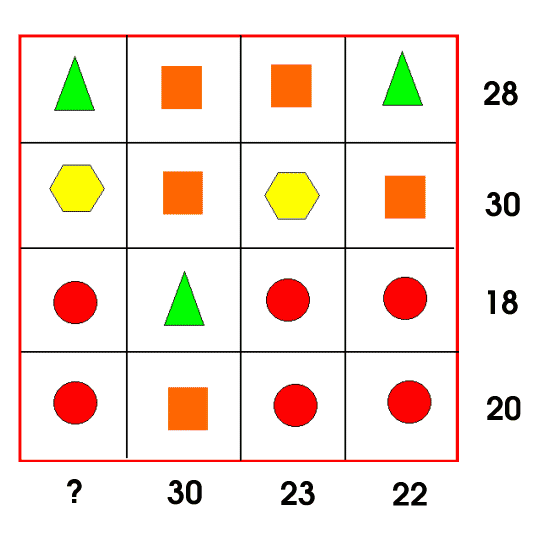Or search by topic
Number and algebra
Geometry and measure
Probability and statistics
Working mathematically
Advanced mathematics
For younger learners
What's it Worth?



- Problem
- Getting Started
- Student Solutions
- Teachers' Resources
Why do this problem?
This problem provides a good challenge in reasoning, working with multiple unknowns. There are issues of redundancy to think about in the provision of too much information.
Students often get stuck when working on mathematical problems. The focus on multiple methods of solving this problem redirects students' attention away from the negative feelings of being stuck and towards the excitement of realising there are many different approaches. This helps students to develop a more resilient mindset when faced with new mathematical situations.
This is a pre-algebra task that can introduce students to the sort of manipulations that can be used to solve simultaneous equations.
Possible approach
Show the grid below, or hand out this worksheet, or display this slide.
"Each symbol has a numerical value. The total for the symbols is written at the end of each row and column."
"Can you find the missing total that should go where the question mark has been put?"
"This is a really interesting problem because it can be solved in lots of different ways. Can you find more than one way to do it?"

"There's a lot of information in the grid, so you had to make some choices about what to focus on first. Each image on the worksheet draws your attention to particular parts of the grid. What can you deduce from each? How can each help you to solve the problem?"
We've set out the worksheet so if you don't want everyone to work on every image, you can give half the class the odd numbered images and half the class the even numbered images.
"In a while, I'm going to invite you up to the board to present your favourite method as a completed solution, so be ready to explain every part of your thinking clearly, and to justify why it is your preferred approach."
Here are some prompts that could be offered to students working on the different approaches if they get stuck:
"If you could work out the value of the square/hexagon/circle/triangle, how could you then work out the value of the triangle/circle/hexagon/square?"
"What can you deduce by comparing the bottom two rows?"
Finish off by inviting students to the board to share the completed methods, together with any other methods they thought of for themselves.
The same techniques can be applied to the problems generated by the interactivity in Fruity Totals
Possible support
Students could work in pairs to make sense of the different methods.
The problem could be solved by trial and improvement, so suggest students choose a value for a particular shape and explore the consequences.
Possible extension
Can students work out how much information is necessary to solve the Fruity Totals problems uniquely, and identify redundant information?
You may also like
Rudolff's Problem
A group of 20 people pay a total of £20 to see an exhibition. The admission price is £3 for men, £2 for women and 50p for children. How many men, women and children are there in the group?
Polycircles
Show that for any triangle it is always possible to construct 3 touching circles with centres at the vertices. Is it possible to construct touching circles centred at the vertices of any polygon?

